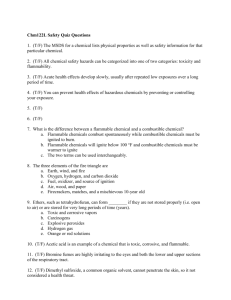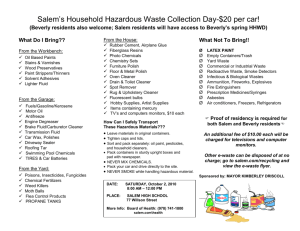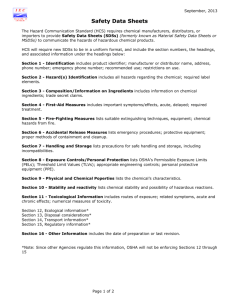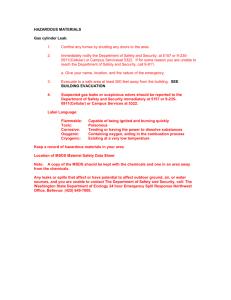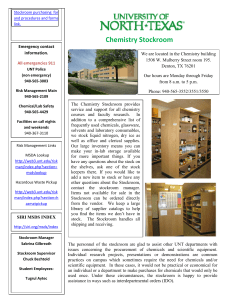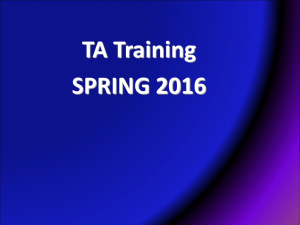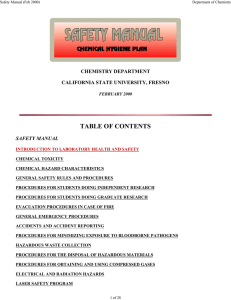Additional Safety Information, Chemistry Lab 108L and 111L
advertisement
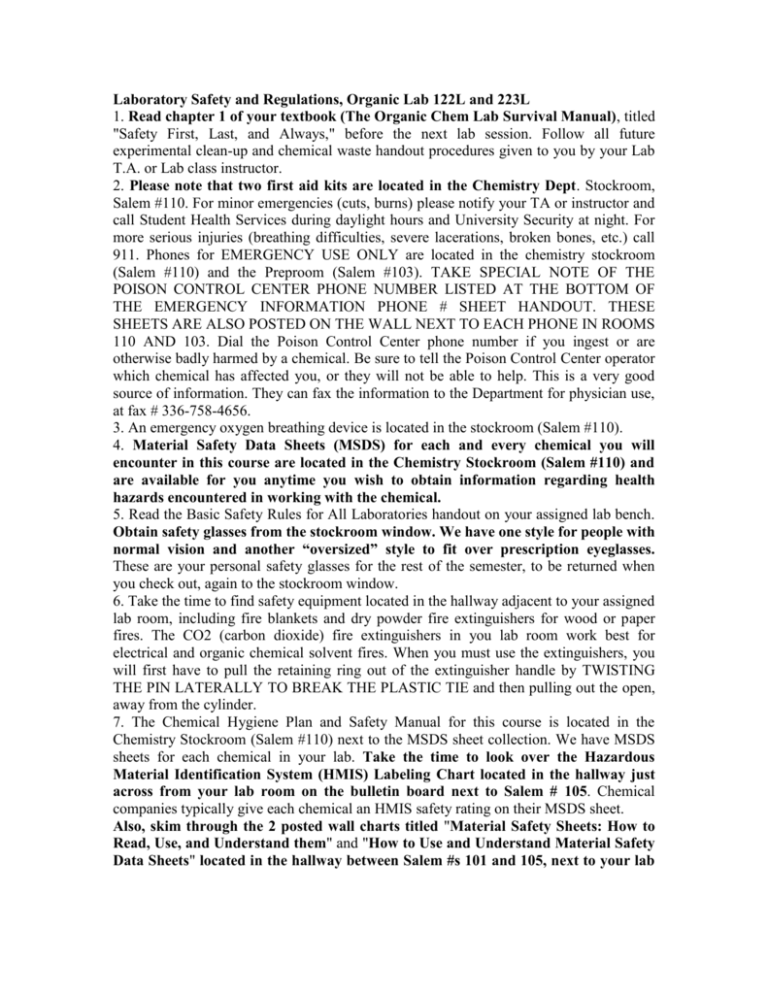
Laboratory Safety and Regulations, Organic Lab 122L and 223L 1. Read chapter 1 of your textbook (The Organic Chem Lab Survival Manual), titled "Safety First, Last, and Always," before the next lab session. Follow all future experimental clean-up and chemical waste handout procedures given to you by your Lab T.A. or Lab class instructor. 2. Please note that two first aid kits are located in the Chemistry Dept. Stockroom, Salem #110. For minor emergencies (cuts, burns) please notify your TA or instructor and call Student Health Services during daylight hours and University Security at night. For more serious injuries (breathing difficulties, severe lacerations, broken bones, etc.) call 911. Phones for EMERGENCY USE ONLY are located in the chemistry stockroom (Salem #110) and the Preproom (Salem #103). TAKE SPECIAL NOTE OF THE POISON CONTROL CENTER PHONE NUMBER LISTED AT THE BOTTOM OF THE EMERGENCY INFORMATION PHONE # SHEET HANDOUT. THESE SHEETS ARE ALSO POSTED ON THE WALL NEXT TO EACH PHONE IN ROOMS 110 AND 103. Dial the Poison Control Center phone number if you ingest or are otherwise badly harmed by a chemical. Be sure to tell the Poison Control Center operator which chemical has affected you, or they will not be able to help. This is a very good source of information. They can fax the information to the Department for physician use, at fax # 336-758-4656. 3. An emergency oxygen breathing device is located in the stockroom (Salem #110). 4. Material Safety Data Sheets (MSDS) for each and every chemical you will encounter in this course are located in the Chemistry Stockroom (Salem #110) and are available for you anytime you wish to obtain information regarding health hazards encountered in working with the chemical. 5. Read the Basic Safety Rules for All Laboratories handout on your assigned lab bench. Obtain safety glasses from the stockroom window. We have one style for people with normal vision and another “oversized” style to fit over prescription eyeglasses. These are your personal safety glasses for the rest of the semester, to be returned when you check out, again to the stockroom window. 6. Take the time to find safety equipment located in the hallway adjacent to your assigned lab room, including fire blankets and dry powder fire extinguishers for wood or paper fires. The CO2 (carbon dioxide) fire extinguishers in you lab room work best for electrical and organic chemical solvent fires. When you must use the extinguishers, you will first have to pull the retaining ring out of the extinguisher handle by TWISTING THE PIN LATERALLY TO BREAK THE PLASTIC TIE and then pulling out the open, away from the cylinder. 7. The Chemical Hygiene Plan and Safety Manual for this course is located in the Chemistry Stockroom (Salem #110) next to the MSDS sheet collection. We have MSDS sheets for each chemical in your lab. Take the time to look over the Hazardous Material Identification System (HMIS) Labeling Chart located in the hallway just across from your lab room on the bulletin board next to Salem # 105. Chemical companies typically give each chemical an HMIS safety rating on their MSDS sheet. Also, skim through the 2 posted wall charts titled "Material Safety Sheets: How to Read, Use, and Understand them" and "How to Use and Understand Material Safety Data Sheets" located in the hallway between Salem #s 101 and 105, next to your lab rooms. Completely read through the wall chart titled “Hazardous Waste Chemical Inventory” on the wall next to room # 103. 8. Other sources of risk assessment information (i.e., how to determine whether a certain chemical is toxic or otherwise dangerous to work with) can be found in the departmental Stockroom, Salem # 110. Their descriptions follow: A very good reference for toxic hazards of general categories and classes of chemicals is: Patnaik, Pradyot. A Comprehensive Guide to the Hazardous Properties of Chemical Substances. New York: Van Nostrand Reinhold, 1992. Consult the following book for hazards due to reactivity of particular chemicals: Urben, P.G., ed. Bretherick's Handbook of Reactive Chemical Hazards, 4th edition. Oxford: Butterworth-Heinemann Ltd., 1995. Another good hazardous chemical reference for particular chemicals is: Lewis, Richard J., Sr., Hazardous Chemicals Desk Reference, 3rd edition. New York: Van Nostrand Reinhold, 1993. The two volume set of Lenga, Robert E. Sigma-Aldrich Library of Chemical Safety Data, 2nd edition. Milwaukee, WI: Sigma-Aldrich Corporation, 1988, is a huge collection of safety information for specific Organic chemicals. The American Conference of Governmental Industrial Hygienist’s Threshold Limit Values (TLVs) booklet is kept there as well. TLVs are the maximum allowable inhalation levels of chemicals present in the laboratory air, measured in milligrams per cubic meter (mg/m3) or parts per million (ppm) in the air you breathe in the immediate vicinity of your work. OSHA has adopted the TLVs and refers to them in the law as Permissible Exposure Levels (PELs). The hoods in your lab are designed to keep exposure levels below the PELs of chemicals you use. Find this booklet with the other books listed above in the Chemistry Department Stockroom, # 110. The Bowman Gray School of Medicine's summary titled "Health Hazards of Some Common Chemicals" is included in your online information page for this course. You will probably find that this is the most useful source information for the hazards of most of the chemicals you will be using in this lab.
